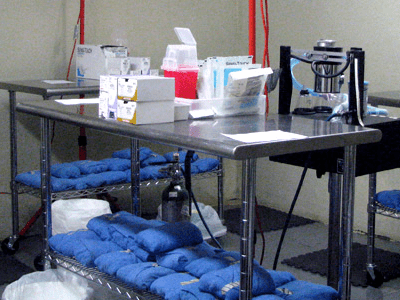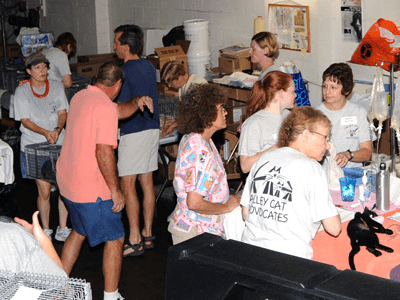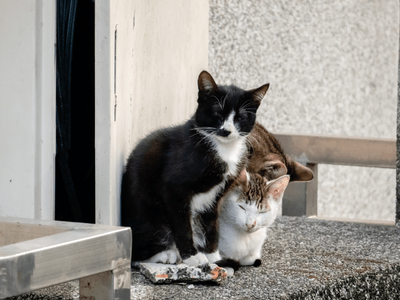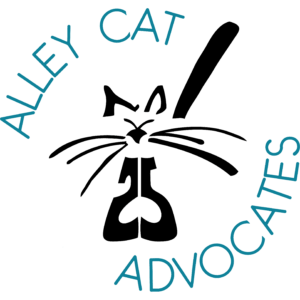
Quick Fix
Alley Cat Advocates’ Quick Fix program is the name of our ongoing spay/neuter clinic program.
Quick in that surgeries are typically scheduled the week after a call by a caretaker; fix in that cats are “fixed” every week of the year.
We are currently scheduling over 200 cats a week for this life-changing spay/neuter surgery.
Please note: Alley Cat Advocates is a non-profit organization supported by donors like you. Our funding varies throughout the year depending on support provided by our donors. You will be encouraged by staff and volunteers to donate so that we can continue to offer these surgeries at the current low and no cost pricing. Please help support this work so that we can continue to provide this valuable service to you and your neighbors.
The Process

Our Services & Costs
Community Cat Package
All cats, 2+ pounds in weight
- Spay/neuter surgeryVaccinations (Rabies and FVRCP)
- Flea Treatment
- Ear-Mite Treatment
- Deworming
- Pain Medication
- Subcutaneous Fluid support
- Ear-tip
- Scan for microchip
- Additional services to treat illness or injuries
Cost
- Cats living in Jefferson County: $0
- Cats living outside of Jefferson County: $40 inclusive of all services
NOTE: Vouchers and grant support are often available to reduce the $40 cost. Call us for details.
Community Kitten Package
All kittens, under 2 pounds with their mom
- Deworming
- Flea Treatment
- Vaccination (FVRCP) if 1+ pounds in weight
- Bottle feeding or feeding appropriate to weaning kittens while mom is in surgery
Cost
- No cost

Past Programs
In the past, Alley Cat Advocates offered other programs in addition to the Quick Fix. While we no longer offer them, we will want to highlight and remember all the good these programs provided our community.


Big Fix
The Big Fix was a large-scale spaying and neutering clinic for community cats, staffed by volunteers and volunteer veterinarians that was the mainstay of Alley Cat Advocates from 2001 through 2016. A fantastic opportunity to get cats spayed or neutered efficiently and effectively, over 24,000 cats were altered through the Big Fix in those 15 years..
Typically held an average of once a month, Alley Cat Advocates spayed/neutered, vaccinated and provided veterinary care to an average of 150 community cats at each event.
This was an all-volunteer experience – even the veterinarians were volunteers. For this service we required no set fee; however we did actively seek donations. Without donations we would not have been able to offer this amazing service.
The Big Fix started with a call to our hotline from a caretaker. Caretakers may have been caring for one cat or 30! Caretakers provided food, water, and shelter for the unowned cats in their area. The only thing missing was spaying and neutering, this was where the Big Fix came into play.
Each Big Fix happened over a weekend. Trap pick up and training was on Friday night and trapping was done on Saturday. Trapping was either an all-day affair or it might just take 10 minutes – the cats helped decide this one! Once trapped, the cats were brought to our clinic location – a warehouse repurposed into a spay/neuter clinic – on Saturday night. Cats were checked in and tagged. Each cat got two tags, one for the trap and one to go around their neck when they were removed from their trap. This ensured that the cats went back in the right traps and were returned to the right place.
show more
Cats were also checked for medical issues and then situated for the night. Small kittens were taken to our kitten care area. We had a dedicated volunteer at each Big Fix to care for kittens. The volunteer fed and monitored the kittens until they were reunited with their mom the next day. It sure was a tough job to love on all of those sweet kitties!
Sunday morning was the big day! Surgeries started in the morning and went until mid to late afternoon depending on the number of cats. On average we spayed and neutered 150 cats at a Big Fix event. The first step for the cats on their lucky day was the sedation area. Once asleep they moved on to the prep station where they were prepared for surgery.
When the cats were removed from their traps, each trap went to Housing Improvement where it was cleaned thoroughly so the cats had a fresh trap after they woke up. Then the cats moved to post prep where a volunteer monitored heart rate and respiration until the cats moved into surgery. Once the cats were asleep until they were fully awake, they were constantly monitored by volunteers.
The cats then moved into surgery. There wer usually 6-8 fully licensed, volunteer veterinarians at each BIG FIX. There were also surgical assistants to aid the vets. How lucky these cats were to receive such dedicated care from our vets, vet techs, and volunteers! Each female got her own, fully sterilized spay pack. We had very busy autoclave volunteers at each Big Fix, sterilizing spay packs for the next event!
After coming out of surgery the cats went to the ear tipping station. At this table each cat received an ear tip (just the very tip was removed). This is a universally accepted symbol that the cat was spayed or neutered and was part of a managed colony. This kept the cats from getting trapped again and having to go through their big day twice! Then the cats got a rabies vaccination, a FVRCP (distemper) vaccination, a dose of flea treatment, a thorough ear cleaning, including topical ivermectin for ear mites, subcutaneous fluids, and once over lots of TLC while they were still asleep!
Then it was on to recovery! At recovery, volunteers monitored the cats until they were awake enough to go back in their trap. Volunteers rubbed on the cats to stimulate them to wake up. Cats were usually groomed and, of course, they received lots of affection at recovery. Once the cats were back in their traps volunteers continued to constantly check each cat. Later in the evening when the cats were fully awake they were given food and water. Moms were also reunited with their kittens. Each incision was checked on Sunday night and someone spent the night with the cats.
Early Monday, the cats incisions’ were checked again and they received food and water. On Monday evening, caretakers returned to the clinic location to pick up their cats. Cats were checked one last time before they left. Once they returned home, they were ready to be released! What lucky cats!
Read Less


Alley Cat Neighborhoods Program
In 2010, Alley Cat Advocates, in partnership with Louisville Metro Animal Services (LMAS), received a $75,000 grant from PetSmart Charities. The goal of the grant was to provide targeted Trap-Neuter-Return (TNR) services to a neighborhood with a large number of stray cats that were traditionally ending up at Louisville Metro Animal Services and were most likely euthanized. PetSmart Charities wanted to fund a program that would significantly reduce the intake of cats at LMAS (and therefore the euthanasia of those cats). In doing so, it they hoped to also demonstrate the effectiveness of targeted TNR. Locally, this program was called the Alley Cat Neighborhoods Program.
This targeted neighborhood approach was wildly successful. In 2009, 1119 stray, unowned cats were turned into Louisville Metro Animal Services from the 40215 zip code. By 2011, this number had dropped to 550 annually. This 51% reduction of cats occurred after only 800 spay/neuter surgeries had been performed as part of the Neighborhoods Program. These results were replicated when we expanded the program to other zip codes in subsequent years.


Operation City Kitty
This program was our community’s precursor to what is now commonly called either Return-to-Field or Shelter-Neuter-Return by municipal shelters across the country. Return-to-Field and Shelter-Neuter-Return programs were and are now focused on getting stray cats that arrive at municipal shelters out of the shelters alive. Before these programs were commonplace, Alley Cat Advocates realized that for the greatest impact, we needed to partner with our municipal shelter to save cats. We also recognized that there was a huge need for the shelter staff and our volunteers to understand the work of the other group. This program got that understanding started and was put into place to facilitate the implementation of the updated Louisville/Jefferson County ordinance, updated in late April 2012, that mandated the use of Trap-Neuter-Return and Return-to-Field for cats in our community.
What our volunteers received from Operation City Kitty, a program we ran in the years between 2012-2016, was the feeling of saving a life. This program was designed to keep cats from entering our community’s shelters and, for those who did enter the shelter, to get them back home safe and sound.
Read More
Unowned cats received at Louisville Metro Animal Services, our municipal shelter, with their ear tipped were returned to their neighborhoods unharmed. Unowned cats received at the shelter without an ear-tip were spayed/neutered and returned to their neighborhood. An average of 70 cats per month went through the program in these early days of Return-To-Field.
To make the lives of community cats better in their home neighborhoods, Alley Cat Advocates also worked to improve relations between caretakers and their neighbors. Volunteers accompanied Metro Animal Services officers on neighborhood rides, meeting with residents, resolving conflicts over community cats, and offering TNR services. Volunteers and Metro Animal Services officers also partnered as trappers, trapping for citizens who need physical or transportation assistance. These activities served not only to directly help cats but also helped to further the understanding of the challenges faced by animal control officers and helped them understand the lingo – and the ultimate goals – of Return-To-Field (and Trap-Neuter-Return).
Ride-alongs and flyer distribution also educated neighborhood residents about the benefits of the services Louisville Metro Animal Services and Alley Cat Advocates were providing in partnership and the support we could noth provide to their community cat populations.
This program, careful in its planning and implementation, laid the groundwork for a successful shelter managed Return-To-Field program that has saved thousands of cats’ lives and survives and thrives as a lifesaving program to this day.
Read Less
